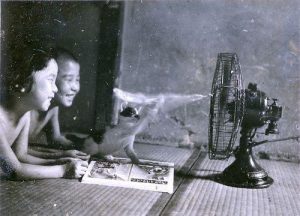The stories of Hiroshima survivors offer some healing and some hope
To walk the halls of Hiroshima’s Peace Memorial Museum is to trace humanity at its worst—and its best.
In this place of human shadows etched onto stone are too many reminders of the too many victims of the world’s first nuclear bomb used in war. A lock of hair. Ripped school uniforms. A death certificate for a 10-month-old baby, her only legacy because she lived too short and died too young to leave a photo behind.
These are just some of the stories of those 70,000 to 80,000 who immediately died after the United States dropped ‘Little Boy’ on Hiroshima on 6 August 1945—as well as those who somehow survived the blast and firestorm that followed to tell the tale.
Telling the stories of these survivors, hibakusha in Japanese, is becoming more important—they are ageing, and their memories are fading. For many, only now have they been able to confront the past.
Increasingly it is up to ‘storytellers’ like Michiko Yamaoka to ensure that the memories of the A-bomb victims live on. Her mother, Kiyoko, then a 20-year-old, survived. Kiyoko’s 13-year-old sister, Atsuko, did not.
‘My mother is 91 now,’ she tells us, ‘and can’t really talk any more.
‘Yet, to this day she cries when she recalls how, when looking for her sister, she didn’t give water to other survivors who were begging for one small drop. She will never forget the look on their faces as they begged.
‘At the time, they thought that survivors would die from drinking water.’
Michiko Yamaoka’s mother also feels that only those who lived through the bomb will truly know what it was like. Nonetheless, her daughter is committed to making sure her tale is told.
Officially Michiko Yamaoka is a ‘memory keeper’—a title given to those entrusted to ensure that Hiroshima and the rest of the world never forget what happened on that day 71 years ago.
In Hiroshima today, there are 70 such storytellers working in Japanese, and five working in English. Of these, three, including Michiko Yamaoka, are ‘second-generation survivors’—directly related to bomb victims.
Recollections
Her stories leave scars. There are the recollections of bloated, bloodied bodies floating up and down Hiroshima’s rivers, drifting in and out on the tides. She tells us of people, so parched and burnt, getting sick with radiation after drinking the ‘black rain’ that followed the blast.
Then there is her auntie. After searching for two days, Kiyoko found Atsuko in a makeshift camp for survivors.
‘Atsuko! Atsuko!’
‘I’m here,’ came the weak reply.
So disfigured was Atsuko’s face that Kiyoko only recognised her younger sister from her voice. But, as she lay and suffered, it was Atsuko who asked Kiyoko if she was okay. She died soon after.
As devastating as the bomb was, it would have been far worse if all 64 kilograms of the enriched uranium packed inside underwent nuclear fission instead of just 800 grams
Michiko Yamaoka’s stories also offer some healing and some hope. There are miraculous escapes. She tells us how, in a few months, new buds sprouted in a wasteland where people said nothing would grow for 75 years.
And as devastating as the bomb was, it would have been far worse if all 64 kilograms of the enriched uranium packed inside underwent nuclear fission instead of just 800 grams—if that is even possible to imagine.
But, Michiko Yamaoka is quick to tell us that, even though they are still waiting for an apology, the victims have forgiven the United States, and hope ‘for a world where everyone can live in peace’.
It is here that we see the best and worst of ourselves. A world hell-bent on destruction. A human spirit reforged in the fires of hell and unbending in its commitment to peace. And a world without nuclear weapons.

In another small corner of the museum, I stumbled across a set of photos from the Suzuki family. As a father of a three-year and three-month-old, one leaves me broken-hearted. It shows the Suzuki’s eldest son, Hideaki, and their eldest daughter, Kimiko, laughing as their kitten plays with a small cloth tied to a fan. Their joyous smiles bring radiant colour to black and white.
Four years later both children were gone forever.
When the bomb and all its devastation came, Hideaki and Kimiko were at school. Although seriously injured, the 12-year-old boy carried his nine-year-old sister on his back to a relief station, where he left her. She was never seen again. He died, bleeding profusely, in the care of relatives several weeks later.
The children’s father, as well as baby brother and sister—aged three and one—were also taken by the blast. The younger children’s bones were later discovered in the smouldering ruins of the family’s barber shop. Their mother, hearing of her husband and four children’s deaths, lost her mind and threw herself down a well.
Of this family, their hopes and fears, highs and lows, black-and-white photos taken by a proud father and amateur photographer are all that remain. A small part of their story immortalised in a series of candid shots of everyday life too painful to look at, too important to look away from.
Stories not only tell us who we are, but what we want to be. It is for this reason that they have been integral to the human condition for all of our history.
The stories of Hiroshima need to be told; they need to be committed to memory, never forgotten. Not only for today’s world but the sake of tomorrow.
Otherwise, nothing will remain.
James Giggacher recently co-convened a two-week Australian National University study tour, ‘Media and Politics in Japan’, with Ritsumeikan University under the Australian Government’s New Colombo Plan.
Featured image
A diorama at the Peace Museum, commemorating the bombing of Hiroshima on 6 August 1945. Photo: Cédric Vanvelthem, published under a Creative Commons licence.

